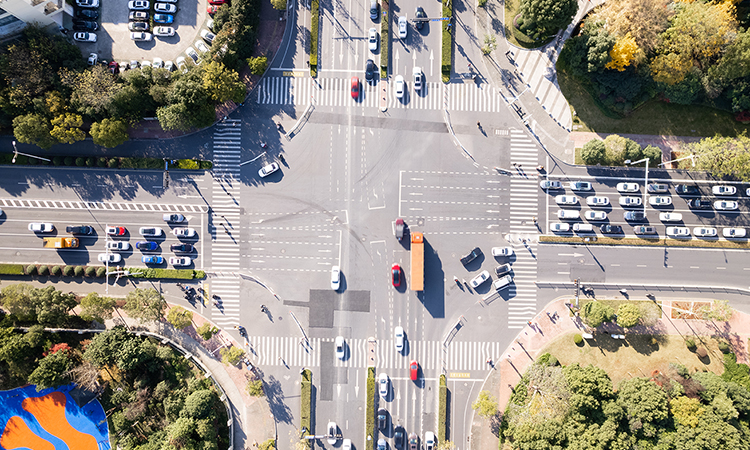Turning Data Into Decisions: Our 2025 Freight Impact and 2026 Vision
See how we helped planners improve safety, efficiency, and data-driven decision-making in 2025 — and where we’re heading in 2026.

With the boom of online shopping, on-demand delivery, shared mobility and rideshare services, curbside space is valued at an all-time high in city centers. Planners and cities are working to understand how curbside space is used to build more efficient infrastructure or inform policy recommendations that alleviate congestion while improving safety and traffic flow. While building out more curb space is not always possible, alternatives could be bringing in overnight loading zones or implementing different types of paid or priority curb spaces.
Insights from Altitude by Geotab’s new product Stop Analytics are helping to fuel these new curbside programs by looking into why vehicles are stopped, where they stopped and how exactly they are currently using curbside space.
The real game changer for Stop Analytics, and the rest of the data solutions from the Altitude platform, is the ability to classify and customize commercial vehicle activity to your analysis needs (e.g., distinguish between smaller weight class vehicles that are traveling for commercial activity instead of personal use). With vocational information at your fingertips, you can distinguish commercial vehicle behavior instantly. Altitude by Geotab data is derived entirely from commercial vehicle activity, eliminating the guesswork of looking at how commercial vehicles use the road and providing an extra layer of contextual information.
Commercial vehicle mobility is the lynchpin for regional economic development and a thriving e-commerce ecosystem. These vehicles’ ability to navigate traffic networks and curbside programs for permissible parking will dictate how quickly deliveries are happening—or not.
It all comes down to how much curb space is available for commercial vehicles. Efficient services and smooth deliveries will require a dependable level of curbside capacity in particular locations during certain times of the day. With Stop Analytics, planners can dive into when delivery parking events occur throughout the day in their regions or custom-defined geographic zones.
Knowing why, when, where and for how long these parking events are taking place will help urban planners figure out the necessary curb space for more efficient deliveries and to alleviate double or unauthorized parking.
Stop Analytics data can also help pinpoint where new neighborhood loading zones would be best placed or where existing loading zones might negatively impact traffic flow. Some cities, like New York, have looked to build off-hour delivery programs, and again, Stop Analytics insights can inform the best hours of operation based on demand for these types of events. Cities can now figure out the ideal curbside situation for reliable delivery programs to ensure businesses get the goods they need promptly, boosting their e-commerce models.
With Stop Analytics, planners can measure the performance at each curb to see if they’re pulling their weight in supporting commercial vehicle activity with proper parking. Motorists and planners alike are acutely aware of when a lack of sufficient parking leads to bottlenecks and traffic congestion. When commercial vehicle stop events occur in non-designated curb areas, congestion might creep into the entire corridor, causing longer travel times and safety issues.
Safety issues can arise when commercial vehicles stop along sidewalks in neighborhoods where they shouldn’t be. In that case, general traffic has to re-route unexpectedly or maneuver around these parking events, which can lead to dangerous driving.
Insights into commercial vehicle stops can be crucial for planners in determining where updated signage is required for the general public to familiarize themselves with the parking events allowed in the region so they can drive accordingly.
Currently, obtaining these parking insights is difficult to assess with stationary cameras located only at certain roadways and intersections. Manual processing is then required to get vehicle counts and determine stop durations. Stop Analytics now easily pulls this information for commercial vehicle activity in seconds through a point-and-click interface or directly through the API.
Pinpointing parking hotspots and curbs at their capacity is the type of analysis that Stop Analytics is built for. It provides planners with the tools to establish better commercial vehicle parking modal prioritization and paves the way for new infrastructure projects.
Projects could include cities looking to support electrification in their region and even building out green loading zones specifically for electric vehicles needing the curb. Stop Analytics allows you to drill down into engine type to distinguish diesel from gasoline or electric to help planners see how efficiently those green curb programs are performing and if they’re truly being used by cleaner energy vehicles.
We’re looking forward to supporting the creation of more sustainable road networks and curbside management programs that keep both motorists and commercial vehicle activity humming.
For more information about Stop Analytics, visit our webpage.